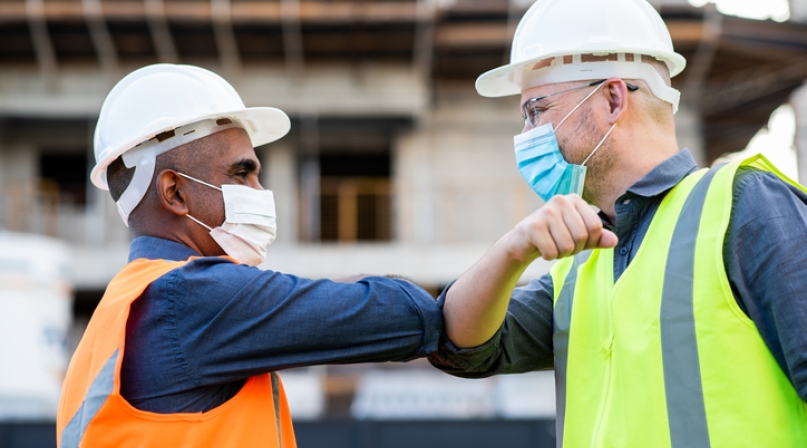Safer Federal Workforce Task Force issues guidance on COVID-19 workplace safety for federal contractors and subcontractors
Author

Blaire Bryant

Michael Matthews
Upcoming Events
Related News

Key Takeaways
On September 24, the Safer Federal Workforce Task Force published guidance on COVID-19 workplace safety for federal contractors and subcontractors. The guidance was published under the direction of President Biden’s Executive Order 14042, “Ensuring Adequate COVID Safety Protocols for Federal Contractors,” signed on September 9, which instructs federal agencies to require contractors and subcontractors to comply with specific COVID-19 workplace safety protocols. The order is part of President Biden’s Path Out of the Pandemic: COVID-19 Action Plan, which aims to increase the number of vaccinated Americans and stop the spread of the virus.
The 14-page guidance includes definitions, explanations and exceptions, that cover federal “contractor and subcontractor workplace locations and individuals in those locations working on, or in connection with a Federal Government contract or contract-like instrument.”
Definitions of covered entities are as follows:
- A covered contractor is any prime or subcontractor who is involved in a contract or contract-like instrument as defined in section 5(a) of Executive Order 14042.
- A covered contractor employee is a full- or part-time employee of a covered contractor who is working on or in connection to a covered contract or at a covered contractor workplace, including employees who are not working in relation to a covered contract.
- A covered contractor workplace is any worksite where an employee working on or in connection to a covered contract is expected to be present during the duration of the covered contract. An employee’s private residence is not considered to be a covered contractor workplace.
Those covered under the guidance must adhere to the following protocols:
- All covered contractor employees must be fully vaccinated against COVID-19 by December 8, 2021, unless they are legally entitled to an accommodation. After December 8, covered contractor employees are required to be fully vaccinated by the first day of covered contract’s performance period. Covered contractors are also required to review proof of vaccination to confirm a covered contractor employee’s vaccination status.
- All individuals, including covered contractor employees, visitors and others, must comply with Centers for Disease Control and Prevention (CDC) guidance for masking and physical distancing while on-site at a covered contractor workplace, with few exceptions. Fully vaccinated individuals must wear a mask indoors while in counties with high or substantial community transmission, but not in counties with low or moderate community transmission. Covered contractors are expected to use the CDC COVID-19 Data Tracker County View website to determine relevant community transmission levels for all their covered contractor workplaces.
- Covered contractors are required to appoint an individual to manage implementation of this guidance at covered contractor workplaces. This person will be responsible for communicating with covered contractor employees and others present at covered contractor workplaces about the applicable safety protocols and requirements, including masking and physical distancing. A covered contractor may also designate more than one person to handle this task.
These new federal protocols will be enforced through a clause that must be included in local contract solicitations issued on or after October 15, and in contracts awarded after November 14, regardless of when the solicitation was issued. For those contracts awarded between October 15 and November 14 that are related to a solicitation issued prior to October 15, agencies are “encouraged” to include the clause, but are not required to do so.
The guidance issued by the Task Force is particularly relevant for counties who may participate in a covered contract. It also provides context for those counties working to support local businesses who may be a federal contractor or subcontractor. For more information on federal COVID-19 vaccine mandates and safety protocols for employers, please view NACO’s Employer COVID-19 Vaccine Mandate FAQ.
Resource
Employer COVID-19 Vaccine Policies: Frequently Asked Questions

Related News

U.S. House reintroduces legislation to address the Medicaid Inmate Exclusion Policy
Two bipartisan bills aimed at addressing the Medicaid Inmate Exclusion Policy (MIEP) were recently reintroduced in the U.S. House of Representatives.

House E&C Committee advances SUPPORT Act reauthorization
On April 9, the U.S. House Energy and Commerce Committee marked up the SUPPORT for Patients and Communities Reauthorization Act of 2025. The bipartisan bill aims to reauthorize critical programs that target overdose prevention amid the renewal of the opioid crisis Public Health Emergency declaration.

Bird flu update: What county leaders should know
As of April 7, there have been 70 confirmed cases of bird flu in the United States, but no person-to-person spread has been detected.
